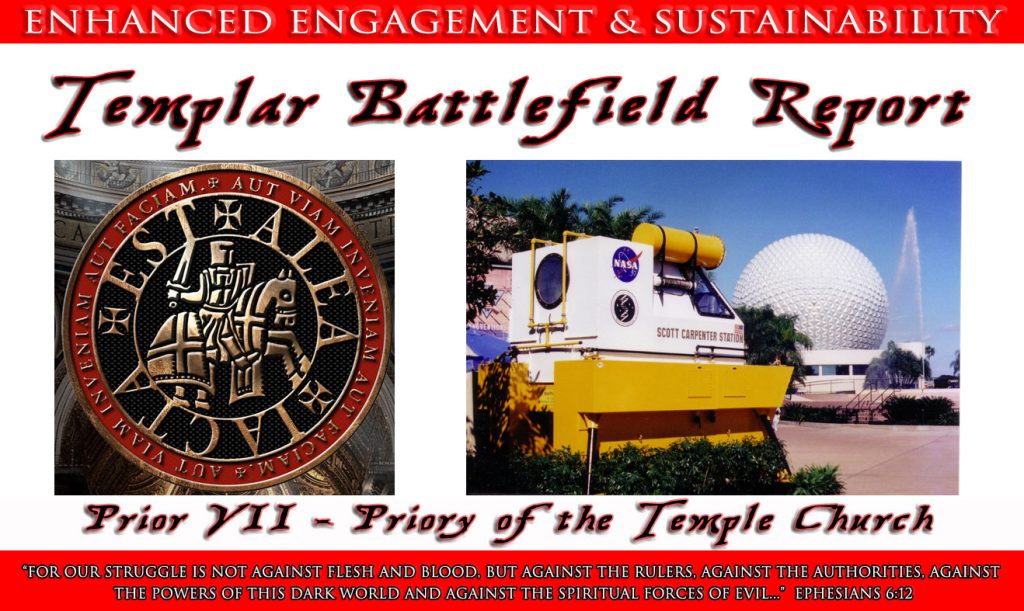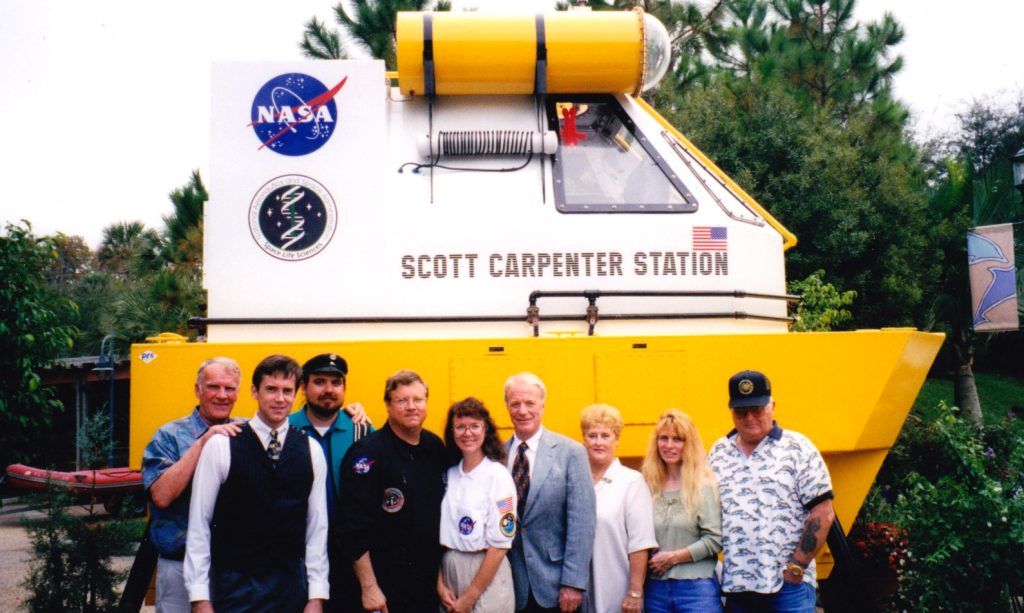
I designed and supervised a contractor-build of the NASA undersea research habitat, the Scott Carpenter Space Analog Station, known as the Carpenter Station. One of the perks of being the Aquanaut Mission Commander on a NASA undersea mission was that I was able to hand-select my Executive Officer. There was no question who I would select: the military-trained, professional, and most competent aquanaut on the planet – Claudia Chaberland. Claudia was already a NASA subcontractor, so the choice was easy.
The Carpenter Station was an ambient pressure habitat, meaning it featured an always-open bottom hatch called a “moonpool.” The pressure inside was exactly equal to the pressure at that point in the water column. As the habitat moved down, the pressure incrementally increased, and more air had to be added to “preserve the bubble.”
US Navy submarines are sealed at 1 atmosphere so that their crews are always protected from extreme external pressure. But their ballast systems are semi-open and typically at ambient pressure, so that their tank pressures are controlled by sophisticated systems specifically designed to protect the bubble.
We were on the Carpenter Station’s 1997 shake-down mission at Key Largo, Florida, and were about to deploy her for the first time to the seafloor 30 feet below. At the point of deployment, we were hovering on the surface, mostly submerged. Claudia and I were inside the habitat, high and dry, monitoring and supervising the operation. There was a three-man underwater crew on the outside tasked with controlling her descent to the bottom. That team was supervised by Chief Engineer Joseph Bishop. My lineup was comprised of the most competent and experienced marine habitat engineers and aquanauts on Earth, all linked together by underwater voice comms.
The Station was designed to employ fixed ballast tanks with valves to adjust her buoyancy, so that when these were filled with water, the habitat had a slight negative buoyancy and would naturally submerge. But when all her tanks were emptied, the Station still clung stubbornly to the top, her roof floating just inches above the surface. Later, we learned that there were air pockets in the ballast tanks of which we were unaware that could not be purged completely.
So, the outside team began to stack ballast on the external frame to make her negatively buoyant. Another diver was stationed at the shore-based compressor enclosure, standing by to flood the habitat with air the second she began her descent, to protect the bubble of air inside and keep it from collapsing. If we did not catch her at just the right moment, it would result in an out-of-control descent to the bottom called “losing the bubble.”
As habitat design and fabrication is a unique field with minimal prototypes, no one had foreseen the specific ballast anomaly we were struggling with. At the time of our mission, there were only three active undersea habitats on the planet.
The deployment stretched into hours of work in the water column to keep the habitat properly trimmed as ballast was procured and added before so that she could finally begin her 30-foot descent to the bottom. Meanwhile, the sun was relentlessly creeping toward the horizon, and we knew our daylight was limited.
It was the perfect prescription for problems arising from unexpected technical issues, long hours of unplanned exposure to the environment, increasing time pressures, and chronic fatigue.
When the bubble was finally lost, it vanished in a fraction of a second. By the time the divers could try to warn us inside the habitat, we were already rushing down toward the bottom.
I clearly remember that it was just like a movie of being inside a sinking ship. The water suddenly swelled up inside the moonpool around Claudia and me, and began filling the habitat. The power remained on, and in the bright lights, we could see everything unfolding in super high-definition terror. The only electrical breaker that popped was for the air conditioner/dehumidifier because it was the sole system mounted down low. All other electrical systems were mounted near the ceiling for this very reason.
In the milliseconds before we contacted the bottom, it got very warm inside the small Station. As the air bubble inside quickly compressed to 1.5 atmospheres, it created immediate heat in a process called adiabatic heating.
Phase one was over in an instant. It was blazing hot inside as we stood waist-deep in crystal clear water.
The divers outside were already removing ballast as fast as they could, while the man at the huge air compressor simultaneously cranked the compressed air feed into the Station up as high as it would go.
__________________________________
In the surface dweller’s world,
life and safety are always found at the surface.
But in the aquanaut’s world,
life and safety are secured under the waves.
__________________________________
A wave of high-pressure air abruptly slammed into the habitat and forced the water back out of the moonpool in a massive vortex, just like a huge toilet flush, carrying all our dive equipment and everything not fastened to the deck with it in a huge circular motion. The divers outside saw a frothing, bubbling, ignominious whirlpool of flushed, very expensive equipment leaving the moonpool in a hurry as the air-filled habitat rapidly began to rise. That was the exact moment that phase two began unfolding in earnest.
Inside the express elevator habitat racing back to the surface with a true purpose, the engineer’s thermodynamic diagram demanded immediate satisfaction. The air around us chilled in an instant by a process called adiabatic cooling. All the moisture suddenly flashed into vapor, rendering the air into a freezing, thick cloud so dense it was difficult to see anything, even Claudia standing an arm’s length away.
In retrospect, it was one of those cases of creating five new problems when the best option would have been to leave the situation alone after crashing to the bottom. Following our hard landing, simply leaving the ballast in place and slowly refilling the habitat with air while it sat on the bottom would have ended the adventure calmly. But this was an initial deployment of a newly designed system, and there was a heightened focus on crew safety. In the surface dweller’s world, life and safety are always found at the surface. But in the aquanaut’s world, life and safety are secured under the waves.
After the Station resurfaced and heart rates returned to normal, the deployment process was repeated more slowly, now knowing exactly how much ballast created the tipping point. Thankfully, the second trip down of the habitat was textbook.
In the end, we had a six-week series of missions in 1997 in Key Largo with no more “adventures.” One of the missions ran concurrently with Space Shuttle Atlantis’ mission STS-86. On board was a “SEEDS in Space” cargo, while we carried an equal amount of “undersea seeds.” At the end of that period, we recovered the habitat and took it on tour to Florida schools that we had linked with, as well as public venues, including Disney’s Epcot (shown above) and SeaWorld accompanied by our namesake astronaut-astronaut Scott Carpenter (shown below).
_________________________________________________________

Left to Right: SeaWorld Official, Mark Ward, Joseph Bishop, Dennis Chamberland, Claudia Chamberland, Scott Carpenter, Patty Carpenter, Sharon Barth, Bob Barth (Sealab I,II,III)
__________________________________________
In 1998, we returned to Key Largo, but this time using a new and improved deployment plan without incident, and enjoyed another six weeks of very successful missions. The highlight of that series was our concurrent mission with John Glenn’s return to flight on Space Shuttle Discovery’s STS-94.
We were lucky. Losing the bubble in a submarine is almost always fatal. In the 1963 case of the USS Thresher (SSN-593), 129 men died when a series of anomalies caused loss of nuclear power. When the crew activated emergency high-pressure air to empty the open ballast tanks and return safely to the surface, adiabatic cooling caused the air nozzles to freeze over and cease functioning. Thus, they failed to recover the bubble, and the boat imploded at about 2,400 feet (more than 400 feet below her predicted collapse depth of 1,950 feet).
Our story is filled with so many examples that Templars can use on our missions each day. Key among them is maintaining situational awareness at all costs, because when the bubble is lost, it is too late to react before real damage is done. Maintaining the bubble is all about situational awareness, to be sure. But preserving that bubble requires adequate training and a clear level of steady, consistent perseverance day after day.
States the Word in Hebrews 12:2, “And let us run with perseverance the race marked out for us, fixing our eyes on Jesus, the Pioneer and Perfecter of faith.”
Why do we count on Jesus for our perseverance? Because, “For by Him all things were created, both in the heavens and on Earth, visible and invisible, whether thrones or dominions or rulers or authorities—all things have been created through Him and for Him. He is before all things, and in Him all things hold together.” (Colossians 1:16-17)
Thus, the final lesson is this: we cannot possibly hold all these complex circumstances together on our own. So, we count on the Lord, because He can… and He does on our behalf! Jesus is the only fixed unit in a vast sea of ever-shifting variables defining life’s equation. It is only He Who can be counted on not to change, waiver, or fail us!
_________________________________________________
